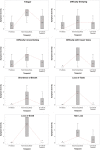Associations between persistent symptoms after mild COVID-19 and long-term health status, quality of life, and psychological distress
- PMID: 35347854
- PMCID: PMC9111447
- DOI: 10.1111/irv.12980
Associations between persistent symptoms after mild COVID-19 and long-term health status, quality of life, and psychological distress
Abstract
Background: We sought to assess whether persistent COVID-19 symptoms beyond 6 months (Long-COVID) among patients with mild COVID-19 is associated with poorer health status, quality of life, and psychological distress.
Methods: This was a multicenter prospective cohort study that included adult outpatients with acute COVID-19 from eight sites during 2-week sampling periods from April 1 and July 28, 2020. Participants were contacted 6-11 months after their first positive SARS-CoV-2 to complete a survey, which collected information on the severity of eight COVID-19 symptoms using a 4-point scale ranging from 0 (not present) to 3 (severe) at 1 month before COVID-19 (pre-illness) and at follow-up; the difference for each was calculated as an attributable persistent symptom severity score. A total attributable persistent COVID-19 symptom burden score was calculated by summing the attributable persistent severity scores for all eight symptoms. Outcomes measured at long-term follow-up comprised overall health status (EuroQol visual analogue scale), quality of life (EQ-5D-5L), and psychological distress (Patient Health Questionnaire-4). The association between the total attributable persistent COVID-19 burden score and each outcome was analyzed using multivariable proportional odds regression.
Results: Of the 2092 outpatients with COVID-19, 436 (21%) responded to the survey. The median (IQR) attributable persistent COVID-19 symptom burden score was 2 (0, 4); higher scores were associated with lower overall health status (aOR 0.63; 95% CI: 0.57-0.69), lower quality of life (aOR: 0.65; 95%CI: 0.59-0.72), and higher psychological distress (aOR: 1.40; 95%CI, 1.28-1.54) after adjusting for age, race, ethnicity, education, and income.
Conclusions: In participants with mild acute COVID-19, the burden of persistent symptoms was significantly associated with poorer long-term health status, poorer quality of life, and psychological distress.
Keywords: COVID-19; COVID-19 outcomes; long-COVID; post-COVID conditions; post-acute sequalae of COVID-19 (PASC).
© 2022 The Authors. Influenza and Other Respiratory Viruses published by John Wiley & Sons Ltd. This article has been contributed to by U.S. Government employees and their work is in the public domain in the USA.
Figures


References
-
- Coronavirus COVID‐19 Global Cases by the Center for Systems Science and Engineering (CSSE) at Johns Hopkins University (JHU) 2020. https://gisanddata.maps.arcgis.com/apps/opsdashboard/index.html#/bda7594...
Publication types
MeSH terms
Grants and funding
LinkOut - more resources
Full Text Sources
Medical
Miscellaneous

